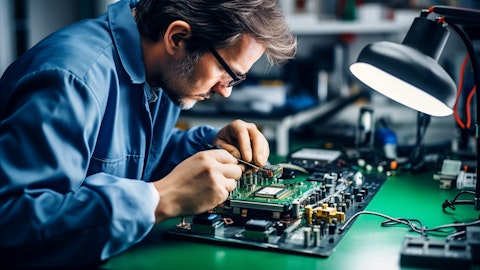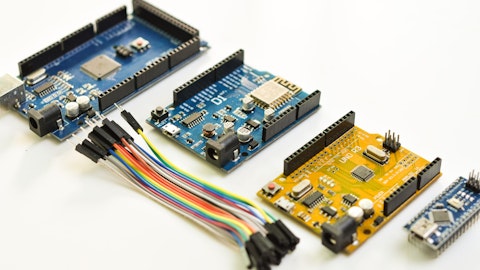Michael Murray: Sure. So, Vision Pro, I think is going to create the adoption rate that we all need in AR/VR systems. It’s really a software platform in my view, which is what they released. They are getting decent companies that are now building apps for the Apple Vision Pro, and that’s just going to enable the market, right? And as that market adoption starts to heat up, so will the rest of the markets, being medical, military, etcetera. So I think the adoption rate is going to increase, Glenn. And we definitely are seeing an uptick in consumer requests for Kopin to work with consumer companies. But I’m very tentative with that right now, based on the level of costs and risks that I see in the consumer marketplace still, right now we see tremendous demand from the military customers with real money, real demand that I can put my finger on.
So we’re tending to focus on that more. Having said that, we do have a consumer strategy that is more of an IP related business. And we’re developing that relationship now and we expect to have some announcements latter half of this year and to be back at CES in 2025.
Glenn Mattson: Okay, that’s it for me. Thanks very much.
Michael Murray: Thanks, Glenn.
Operator: Thank you. [Operator Instructions]. We’ll go next now to Kevin Dede at H.C. Wainwright.
Kevin Dede: Afternoon, gentlemen. Michael, Rich, thanks for having me on.
Michael Murray: Thanks for being here, Kevin.
Kevin Dede: Yes, no, I guess first thing, Michael, your initial remarks spoke to the outline of strategic objectives you offered in the March call last year. I was wondering if you wouldn’t mind sharing sincerely how you think you’ve done and like whether or not, you’ve accomplished as much as you thought you would as rapidly as you have. Or whether or not you think that some of the hiccups that you’ve run into IE problems with source components problems with the fab have delayed the improvement that you thought you could accomplish a year ago?
Michael Murray: I would answer it this way. I think the surprises for me have been, I think the cash spent on the lawsuit has been more than what I expected it to be. And lumpier than we expected it to be. So I think that was a perturbation that I had not expected and caused havoc with our SG&A and our balance sheet quite frankly. So I didn’t quite understand how that was going to impact the year. So that would be number one. Number two, I think the amount of effort that we put into our quality systems, it was more difficult than I had, I’d say appreciated and how much detail was going to be required to be improved, how much documentation was going to need to be improved. And quite frankly, we needed some, I’d say better talent in that area and we went out and got it and now we’re improving the customers are rewarded.
I think the best surprise in last year was the customer’s willingness to work with Kopin, and the fact that they want to give us more. They want to give us more business, and at this point in time they are. And if we keep doing what we are doing, I think we are going to be wildly successful. I am afraid to tell people what our opportunity pipeline is, because the number is so large. So, I think we have got tremendous opportunity to grow the company. And I think it’s just blocking and tackling, keeping our customers happy, and turning out quality products. So, I think that’s where my head is at after a year.
Kevin Dede: Okay. Help me make sure that I have the detail straight here. I could swear that I heard your prepared remarks, you are comfortable with 20% growth, which gets you like $48.5 million this year, your backlogs $55 million and you expect to convert all of it this year. So, sort of help me reconcile those two or correct a problem in my understanding, please.
Michael Murray: Sure. Just conservatism, we want to make sure that we are – our supply chain can support that level of volume. We are buying to that level of volume today and expect to shift that level of volume. But again, we want to make sure that we are very crisp and concise and hit our marks, so that’s the reason for the delta.
Kevin Dede: Okay. Fair enough. Thank you. I was wondering if you could peel the onion back a little bit on the on the thermal sites, understand, you are very excited about that. But could you – I know that you are obviously very involved with the FWSI. But I guess what I don’t understand is, how much foreign interest you are seeing. I thought I understood maybe a $20 million order coming in from a NATO affiliate. Can you just help clarify that?
Michael Murray: No, the $20 million, $25 million that we received this quarter is for the U.S. DOD, it’s the new weapon selection. So, with the new weapon selection, Kevin, along comes a new weapon site. And we had to do some work on the optics to make that weapon site work for this new weapon system. So, that is for U.S. DOD. We did have in 2023, several orders for international weapon sites, specifically long range, and our customer is vying for new business in that area internationally, and they are being successful. So, we will see what happens this year with some of the conflicts that are going on. But in the international market, it is much more price conscientious than I would say the U.S. DOD market, from my understanding.
But I also see opportunity in non-conventional weapons type systems, like off the visor systems as an example, which is one of the things that we worked on with Wilcox and displayed with Wilcox at the Shot Show. So, I think those are new opportunities for us to grow our business and our portfolio. And I think you will hear some exciting news around those technologies as well this year.
Richard Sneider: Yes. Kevin, I would add that, you will see, for instance, a lot of discussion about the U.S. providing arms to the Ukraine as an example, our customers in situations like that is the United States Government. So, it’s not like Ukraine, or some European nation orders, they actually are supplied by the U.S. Government. So, technically, our customer is always the U.S. Government. And sometimes we know where it’s going, and sometimes we don’t.
Kevin Dede: Okay. Thank you. Michael, if you will allow me, you spoke to the backplane development. And I guess making sure that your sources are outside of China. And you mentioned both internally and externally, and I kind of lost your train of thought on that. So, if you could help me kind of understand that, and maybe how the process is different than the way you were looking at it a year ago? And what position that change puts you in going forward?
Michael Murray: Yes. No problem, let me clarify. So, we build our backplanes with a silicon partner. And we control that internally. So, we will send out a wafer request to our partner who is in Asia, not in China, but we will receive those backplanes. And so we build the backplanes, we designed the backplanes. We can deposit certain material, whether it would be OLED, micro LEDs or LCOS and Dalgety Bay as an example. But it’s that deposition partner that I am referring to more specifically as being fab light. The reason why that’s important is we have moved our OLED deposition out of China. We have now signed up a European deposition partner that is adapting our OLED designs, and using their deposition material and process.
And quite frankly, it’s working better than expected. We are getting better quality results, better brightness and power consumption. And probably not power consumption contrast numbers from that partner. So, that’s going very, very well, very impressed with that. But we are also looking at other partners in Korea as an example, that have high volume OLED deposition and capability as well as micro LED technology, and are U.S. DOD approved. So, expanding into that market allows us to still own the backplane which we need to design. That’s where the brains go, the processor itself, the AI, the software that controls the display, the deposition, Kevin of OLED, or LEDs, or what have you is what’s happening at our partners sites. Does that help?
Kevin Dede: Yes. It helps a lot. And I remember it was one of your first initiatives was to move to fab-light. And at that point, was your deposition partner, the one in China, or had you already begun to work with European partner?
Michael Murray: So, the fab-light strategy was put in place because our partner was in China, saying it was a very specific initiative, yes. Because we saw tremendous opportunity in U.S. DOD, and the answer was, we would love to give it to you. But you can’t deposit OLED in China. And I said, fine, we won’t. And now we do not deposit OLED in China for U.S. DOD customers. And we are being very successful in taking share of individual displays and our optical solutions away from some of our domestic competitors. So, that strategy is working quite well, actually.
Kevin Dede: I am trying to shorten up my question was for you, Michael. But I can’t, not let this one go. I would really love to hear an update on the neural display. I think you referenced it, obviously, but not much detail on time to market and any sort of customer acceptance you may have had to this point.
Michael Murray: So, I will update more in the next call with more definitive details. However, we have been out marketing the neural display with I would say a handful of customers and consumer and a handful of very strategic customers in defense. We have also written several research papers, requesting funding for the neural display. And I think we will be successful in getting that funding from the U.S. DOD for soldier vision systems. So, that’s going well, I have a high degree of confidence in that technology and our ability to fund it. That’s number one. Number two, I have the team working on a very stressful timeline right now, where we want to be demonstrable in Q1 of 2025. There won’t be a full 2K display or 4K display, but I believe we will have a demonstrable display in Q1 of 2025 that we can demonstrate for customers utilizing this new technology. And that’s our goal, Kevin. It’s a lock, by the way.
Kevin Dede: So, that Q1 is CES 2025, Michael, which I know you referenced. So, could we be so lucky as to see something there, or am I shooting to the lie?
Michael Murray: Well, let’s put it this way. That’s what I am forcing the engineers towards. But again, I want to stress that is a very lofty goal. But that is the goal. And we are working like mad to make that happen. And we also have a U.S. DOD demonstration that we want to do in Q4, that has now taken priority over that because of the volume of business that we could associate with it. But that’s the goal, Kevin, is 2025 CES. So, we will do our best, but it is a lofty goal.



